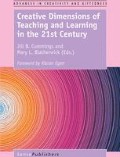Abstract
The need for creativity and innovation as an integral part of 21st century skills in education has been widely espoused by numerous government jurisdictions and private organizations, notably Alberta Education’s Inspiring Education (2010) initiative along with the Partnership for 21st Century Skills (P21) (2009) in the United States and the international Organization for Economic Cooperation and Development (OECD, Ananiadou & Clario, 2009).
Access this chapter
Tax calculation will be finalised at checkout
Purchases are for personal use only
Preview
Unable to display preview. Download preview PDF.
References
Alberta Education. (2010). Inspiring education. Edmonton: Alberta Education.
Ananiadou, K., & Claro, M. (2009). 21st century skills and competencies for new millenium learners in OECD countries (OECD Education Working Papers No. 41). Paris: Organization of Economic Cooperation and Development, OECD Publishing.
Beghetto, R. A., & Kaufman, J. C. (Eds.). (2010). Nurturing creativity in the classroom. New York, NY: Cambridge University Press.
Bocchi, G., Cianci, E., Montuori, A., Trigona, R., & Nicolaus, O. (2014). Educating for creativity. World Futures: The Journal of New Paradigm Research, 70(5–6), 336–369.
Csikszentmihalyi, M. (1995). Creativity. New York, NY: Harper Collins.
Csikszentmihalyi, M. (1996). Creativity: Flow and the psychology of discovery and invention. New York, NY: Harper Collins.
Finke, R. A., Ward, T. B., & Smith, S. M. (1992). Creative cognition: Theory, research and applications. Cambridge: MIT Press.
Kaufman, J. C., & Sternberg, R. J. (Eds.). (2006). International handbook of creativity. New York, NY: Cambridge University Press.
Kaufman, J. C., & Sternberg, R. J. (Eds.). (2010). The Cambridge handbook of creativity. New York, NY: Cambridge University Press.
Kelley, T. (2013). Creative confidence: Unleashing the creative potential within us all. New York, NY: Crown Business.
Kelly, R. W. (2005). Idea generation: Fueling the creative process. BCATA Journal for Art Teachers, 47(2), 4–10.
Kelly, R. W. (2012). Educating for creativity: A global conversation. Edmonton: Brush Education.
Kelly, R. W., & Leggo, C. D. (Eds.). (2008). Creative expression, creative education: Creativity as a primary rationale for education. Calgary: Temeron Detselig.
Leadbeater, C. (2008). We-think: The power of mass creativity. London: Profile Books.
Lubart, T. I. (2000–2001). Models of creative process: Past, present and future. Creativity Research Journal, 13(3–4), 295–308.
Nelson, R. (2008). Learning and working in the collaborative age. Edutopia [Video]. Retrieved from http://youtu.be/QhXJe8ANws8
Osborn, A. (1953). Applied imagination. New York, NY: Charles Schribner.
Partnership for 21st Century Skills. (2009). Learning for the 21st century, A report and mile guide for 21st century skill. Washington, DC: United States Department of Education.
Piirto, J. (2004). Understanding creativity. Scottsdale, AZ: Great Potential Press.
Pink, D. H. (2005). A whole new mind. New York, NY: Riverhead Books.
Pink, D. H. (2009). Drive: The surprising truth about what motivates us. New York, NY: Riverhead Books.
Runco, M. A. (2007). Creativity: Theories and themes: Research, development and practice. San Diego, CA: Elsevier Academic Press.
Smith, G. (1998). Idea generation techniques: A formulary of active ingredients. Journal of Creative Behaviour, 32(2), 107–133.
Starko, A. J. (2010). Creativity in the classroom (4th ed.). New York, NY: Routledge.
Sternberg, R. J. (Ed.). (1999). Handbook of creativity. New York, NY: Cambridge University Press.
Sweeney, J. (2004). Innovation at the speed of laughter. Minneapolis, MN: Aerialist Press.
Author information
Authors and Affiliations
Editor information
Editors and Affiliations
Rights and permissions
Copyright information
© 2017 Sense Publishers
About this chapter
Cite this chapter
Kelly, R. (2017). Creative Development in Teacher Education. In: Cummings, J.B., Blatherwick, M.L. (eds) Creative Dimensions of Teaching and Learning in the 21st Century. Advances in Creativity and Giftedness. SensePublishers, Rotterdam. https://doi.org/10.1007/978-94-6351-047-9_5
Download citation
DOI: https://doi.org/10.1007/978-94-6351-047-9_5
Publisher Name: SensePublishers, Rotterdam
Online ISBN: 978-94-6351-047-9
eBook Packages: EducationEducation (R0)

